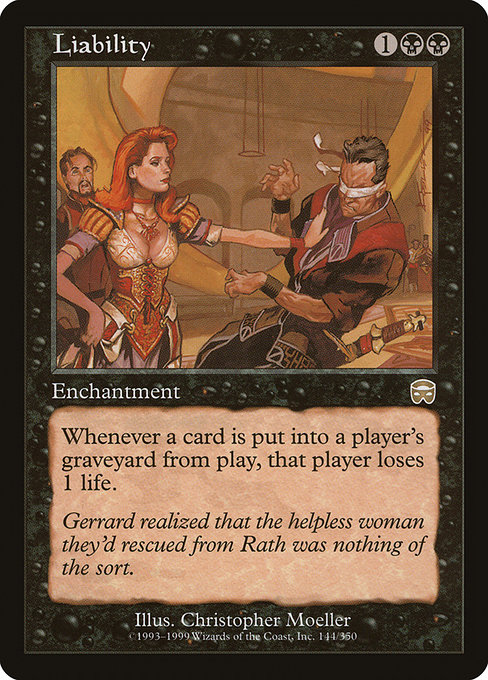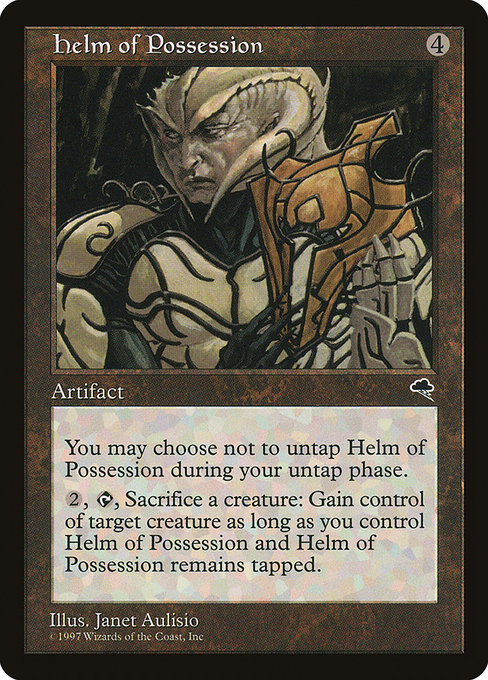I GOT UNMASK ALL WRONG, PEOPLE. APOLOGIES.
In my most recent column, while discussing rk post’s distinctive art for black cards–I made a mistake. Writing about Unmask:
The card is from the set Mercadian Masques, so the card’s theme plays into that, but the woman, so far as I know, isn’t a major player in the lore
How wrong I was. A generous person on Twitter (@SeraphCavotta) pointed out the following:
“the illustration in Unmask does depict a major lore character (two of them, in fact), and a central moment of Masques’ story. The illustration shows Volrath dropping his impersonation of Takara, Starke’s daughter, through whom he has been manipulating Gerrard”



We can see that, yes, the woman (Takara) had been represented before. And that the mask she wore is connected to this villainous character. But in discovering my wrongness, I deepened my understanding of the card Unmask, the lore surrounding the villain Volrath, and the complexity that a Magic: The Gathering card can obtain as piece of art and, ultimately, as a gamepiece. Indeed, there’s a sequence of events that is unraveled. The lore is…involved. I won’t relay all of it here, but it’s sufficient to know the following, which can be followed clearly and in full on MtG Wiki and apologies for any further mistakes:
- Volrath started as Vuel, a human on Dominaria. Gerrard Capashen was his adopted brother.
- Vuel, as a rite of adulthood, failed to climb a perilous plateau because he was sabotaged with poisonous body paint (by Starke il-vec). But he blamed Gerrard, who’d helped him complete the rite and ultimately saved his life.
- This resentment builds to a lifelong grudge against Gerrard–helpfully fueled by the Phyrexians, as well. Though Gerrard meant well, Vuel is shunned by his family and encouraged by Starke (from the invading plane of Rath) to attack and kill his former people.
- What we don’t know is that Starke’s daughter, Takara, is being held captive in the Stronghold on Rath. Starke’s goal is to lure Vuel from Dominaria to Rath and have him become a contorted evincar. In this way, he hopes to have his daughter returned to him.
- Over time, Vuel becomes Volrath and is a horrific evincar, a tool of Yawgmoth, performing experiments and causing agony. He does eventually, as a shapeshifter now, kidnap and keep Takara, replicating her features and insinuating himself among the Weatherlight crew. It is on the ship, and in the card art, that he reveals his true self to some of the crew.
Who’s Under the Skin?
The point of all that lore is to setup the rk post art in Unmask. If you were to look at the card, unbeknownst of all the lore, one can make rough sense of it. The “unmasking” ability of the card is the player’s ability to see an opponent’s hand and choose one and have the other discard it. There is also a visual representation of the unmasking with the red-haired woman (Takara) having an armor-plated mask seemingly removed. But knowing the lore now deeply complicates the visual presentation for a number of reasons.
It’s actually the face of Volrath hanging by tentacles of magical flowstone.

What makes the rhetorical presentation of Unmask so vertiginous now is the layering of knowledge. In the lore, we know that this is Takara. We know that she has been taken and this forces her father’s hand to draw what’s Dominaria (i.e. Vuel and by extension, Gerrard) into Rath (wherein Vuel turns into Volrath). Volrath-as-Takara is a plot point in the story where the motivation is based on deception. And the unmasking of the villain–willingly–is what’s curious. On the surface, this may read as a Scooby Doo-like reveal of a baddie. But then, why would this card be in black? And focused on discard (both for potentially the caster and the opponent)? And is the baddie Takara? No. The scene unfolding is the reverse of what we think. The Takara-face is the mask. The flowstone’d pieces of Volrath are reattaching here, I think. Not the other way around. The unmasking is more properly understood here as an enmasking. Or a refacing.
Had I been paying more attention the first time, I should’ve been upset about the card being in black. But I wasn’t paying attention. I could blame it on the lack of flavor text, but that’s a cop-out. I would argue what makes all of this so deserving of attention is the interaction of lore-density and the presentation of card art. Consider that when you play Unmask, you’re taking the side of Volrath. You’re unmasking yourself (showing your investments in gameplay) and the opponent (by spying their grip). What makes the card more menacing than it ever had been before is that when you play it, the alluring Takara is the face you see, the one you present, and other players may pay less attention to the periphery where the true face is closing in on the lie. Finally, consider how many Magic players love the card art. How it brought many into the game. How it is their favorite piece of card art. I could be wrong (once again), but I think even if Unmask shows us the reverse side of a villain, we can still appreciate the beauty of the drama.
Kyle Winkler (he/him) is a teacher and fiction writer. While he was pre-teen when Magic: The Gathering was released, he didn’t start playing until recently. He’s the author of the cosmic horror novella (The Nothing That Is), a collection of short stories (OH PAIN), and a novel (Boris Says the Words). His favorite card is a toss up between Crypt Rats and Oubliette.

